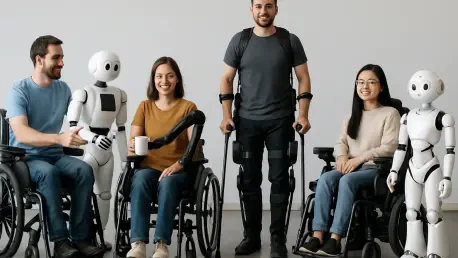In a world where millions grapple with mobility challenges due to strokes, spinal cord injuries, and other disabilities, the quest for independence often feels like an uphill battle, but groundbreaking advancements in robotics are changing the narrative for the better. At the forefront of this transformation stands Habib Rahman, the Richard and Joanne Grigg Professor and mechanical engineering chair at the University of Wisconsin-Milwaukee (UWM), who directs the university’s Biorobotics Lab. His innovative work is redefining how assistive technology can empower individuals to reclaim autonomy in their daily lives. By developing cutting-edge devices tailored to the unique needs of those with limited mobility, Rahman is not just engineering tools but crafting pathways to dignity and self-reliance. This journey, fueled by personal motivation and global technological insights, highlights a pivotal shift in rehabilitation and support systems, promising a future where small victories—like sipping water unassisted—become monumental achievements for many.
Pioneering Assistive Robotics
Habib Rahman’s mission to enhance lives through robotics stems from a deeply personal place, inspired by witnessing family members and a student navigate the debilitating aftermath of strokes. His professional path, spanning from Bangladesh to Japan and Canada before joining UWM, exposed him to diverse perspectives on technology’s role in addressing human challenges. At the Biorobotics Lab, the focus is on creating solutions that directly tackle the barriers faced by individuals with mobility impairments. Devices like wearable exoskeletons, equipped with advanced sensors, motors, and artificial intelligence, adapt to each user’s specific capabilities, offering customized support during physical therapy sessions. These innovations are not merely mechanical; they embody a commitment to restoring a sense of normalcy. By prioritizing user-centric design, Rahman’s work ensures that technology serves as a bridge to independence, enabling people to perform tasks that many take for granted, thus transforming their quality of life in profound ways.
Beyond exoskeletons, Rahman’s team has developed remarkable tools like the iTbot, a portable robotic arm designed to bring therapy directly into patients’ homes, breaking down barriers of accessibility. Another standout invention is a wheelchair-mounted robotic arm, engineered to assist with delicate tasks such as handling a credit card or holding a coffee mug. This device empowers users to feed themselves and manage everyday activities with greater ease, fostering a sense of control over their environment. The meticulous attention to functionality reflects an understanding that independence often hinges on the ability to complete seemingly minor actions without assistance. Such innovations are a testament to the potential of robotics to address both medical rehabilitation needs and the practical demands of daily living. Rahman’s vision extends beyond the lab, aiming to integrate these technologies into the fabric of users’ lives, ensuring they are not just tools but extensions of personal capability.
Breaking Barriers with Accessibility and Funding
A critical aspect of Rahman’s work lies in the push to make assistive robotics not only effective but also widely accessible and affordable for those who need them most. Recognizing that high costs and lack of insurance coverage often hinder adoption, his team is dedicated to designing portable devices that can seamlessly fit into various lifestyles. This effort is supported by a significant $1 million grant from the National Institute on Disability, Independent Living, and Rehabilitation Research, awarded to fund a five-year project that started recently. The initiative aims to adapt the wheelchair-mounted robotic arm for a broader spectrum of users, including individuals with cerebral palsy, multiple sclerosis, and the elderly population. By addressing diverse needs, this project seeks to ensure that assistive technology transcends niche applications, becoming a mainstream solution for enhancing independence across different demographics and conditions.
Collaboration plays a vital role in bringing Rahman’s vision to fruition, as partnerships with organizations like the ALS Association and the Medical College of Wisconsin facilitate real-world testing and feedback from actual users. These alliances help refine the devices to meet specific, practical requirements, ensuring they are not just innovative but genuinely useful in everyday scenarios. The emphasis on affordability and potential insurance coverage underscores a pragmatic approach to overcoming systemic obstacles that often prevent cutting-edge solutions from reaching those in need. This focus on scalability and inclusivity signals a shift in how assistive technology is perceived, moving from a luxury to a fundamental right. By aligning technological advancements with economic and social realities, Rahman’s efforts are paving the way for a future where more individuals can benefit from robotics, regardless of financial or logistical constraints, thus amplifying the impact of these life-changing tools.
Empowering Lives Through Human-Centered Design
At the heart of Rahman’s innovations is a profound belief that everyone deserves a high standard of living, no matter their physical limitations, and that even small, momentary successes can redefine a person’s sense of self. This human-centered philosophy drives the development of each device, ensuring that functionality is paired with empowerment. Whether it’s an exoskeleton aiding in therapy or a robotic arm assisting with a meal, the goal remains consistent: to enable users to achieve tasks independently, thereby fostering confidence and dignity. This approach sets Rahman’s work apart, as it prioritizes the emotional and psychological benefits of autonomy alongside physical support. The impact of such design is evident in the way users reclaim control over their routines, turning ordinary actions into powerful affirmations of their capabilities, and reshaping how society views disability and assistance.
The broader societal implications of Rahman’s research are equally significant, as it challenges traditional notions of dependency and highlights the transformative power of technology when guided by empathy. Drawing from global influences, particularly Japan’s emphasis on robotics for an aging population during his formative years, Rahman has adapted these concepts to address rehabilitation needs in a unique context. His work at UWM reflects a blend of technical precision and cultural sensitivity, ensuring that solutions resonate with diverse populations. The ongoing research, backed by substantial funding, points to an evolving landscape where assistive devices could cater to an even wider array of challenges over the coming years. By focusing on user feedback and real-world application, these innovations are poised to redefine standards of care, making independence a tangible goal for many who once saw it as out of reach, and inspiring further advancements in the field.
Reflecting on a Legacy of Innovation
Looking back, Habib Rahman’s contributions at UWM’s Biorobotics Lab stand as a beacon of hope for countless individuals facing mobility impairments. His development of customizable exoskeletons, portable therapy robots, and assistive arms addressed critical gaps in both rehabilitation and daily living support, offering practical solutions where few existed before. Collaborations with key organizations and substantial funding underscored the trust placed in his vision, reflecting a growing recognition of robotics’ role in healthcare. The journey, marked by a blend of personal dedication and technical brilliance, left an indelible mark on assistive technology. Moving forward, the focus should shift to scaling these innovations, advocating for broader insurance coverage, and fostering global partnerships to ensure accessibility for all. Rahman’s legacy serves as a reminder that technology, when paired with compassion, can transform lives, urging stakeholders to continue investing in solutions that prioritize human dignity alongside progress.









